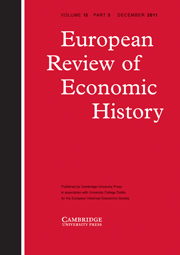Crossref Citations
This article has been cited by the following publications. This list is generated based on data provided by
Crossref.
Ciccarelli, Carlo
and
Fenoaltea, Stefano
2007.
Business fluctuations in Italy, 1861–1913: The new evidence.
Explorations in Economic History,
Vol. 44,
Issue. 3,
p.
432.
Ricciuti, Roberto
2008.
The quest for a fiscal rule: Italy, 1861–1998.
Cliometrica,
Vol. 2,
Issue. 3,
p.
259.
Lippi, Francesco
and
Secchi, Alessandro
2008.
Technological Change and the Demand for Currency: An Analysis with Household Data.
SSRN Electronic Journal,
Malanima, Paolo
and
Zamagni, Vera
2010.
150 years of the Italian economy, 1861–2010.
Journal of Modern Italian Studies,
Vol. 15,
Issue. 1,
p.
1.
Escosura, Leandro Prados de la
2010.
IMPROVING HUMAN DEVELOPMENT: A LONG‐RUN VIEW.
Journal of Economic Surveys,
Vol. 24,
Issue. 5,
p.
841.
Federico, Giovanni
and
Vasta, Michelangelo
2010.
Was industrialization an escape from the commodity lottery? Evidence from Italy, 1861–1939.
Explorations in Economic History,
Vol. 47,
Issue. 2,
p.
228.
Vasta, Michelangelo
2010.
Italian export capacity in the long-term perspective (1861–2009): a tortuous path to stay in place.
Journal of Modern Italian Studies,
Vol. 15,
Issue. 1,
p.
133.
Ciccarelli, Carlo
Fenoaltea, Stefano
and
Proietti, Tommaso
2010.
The effects of unification: markets, policy, and cyclical convergence in Italy, 1861–1913.
Cliometrica,
Vol. 4,
Issue. 3,
p.
269.
Giovanni, Federico
2010.
Paying for the Liberal State.
p.
186.
Malanima, P.
2011.
The long decline of a leading economy: GDP in central and northern Italy, 1300-1913.
European Review of Economic History,
Vol. 15,
Issue. 2,
p.
169.
de la Escosura, Leandro Prados
2011.
Economics and History.
p.
87.
Broadberry, Stephen
Giordano, Claire
and
Zollino, Francesco
2011.
A Sectoral Analysis of Italy's Development, 1861-2011.
SSRN Electronic Journal,
Vaona, Andrea
2012.
Granger non-causality tests between (non)renewable energy consumption and output in Italy since 1861: The (ir)relevance of structural breaks.
Energy Policy,
Vol. 45,
Issue. ,
p.
226.
Broadberry, Stephen
and
Klein, Alexander
2012.
Aggregate and per capita GDP in Europe, 1870–2000: continental, regional and national data with changing boundaries.
Scandinavian Economic History Review,
Vol. 60,
Issue. 1,
p.
79.
Felice, Emanuele
and
Carreras, Albert
2012.
When did modernization begin? Italy's industrial growth reconsidered in light of new value-added series, 1911–1951.
Explorations in Economic History,
Vol. 49,
Issue. 4,
p.
443.
Pistoresi, Barbara
and
Rinaldi, Alberto
2012.
Exports, imports and growth.
Explorations in Economic History,
Vol. 49,
Issue. 2,
p.
241.
Sella, Lisa
and
Marchionatti, Roberto
2012.
On the cyclical variability of economic growth in Italy, 1881–1913: a critical note.
Cliometrica,
Vol. 6,
Issue. 3,
p.
307.
Dalena, Michele
and
Magazzino, Cosimo
2012.
Public Expenditure and Revenue in Italy, 1862–1993.
Economic Notes,
Vol. 41,
Issue. 3,
p.
145.
2013.
The economy of liberal Italy: a roundtable discussion with Brian A'Hearn, Nick Carter, Giovanni Federico and Vera Zamagni on Stefano Fenoaltea's The Reinterpretation of Italian Economic History: From Unification to the Great War. Cambridge: Cambridge University Press, 20111.
Modern Italy,
Vol. 18,
Issue. 1,
p.
81.
De Bonis, Riccardo
and
Silvestrini, Andrea
2013.
The Italian Financial Cycle: 1861-2011.
SSRN Electronic Journal,


